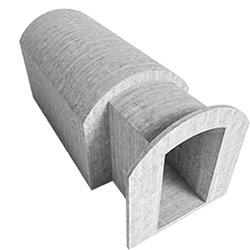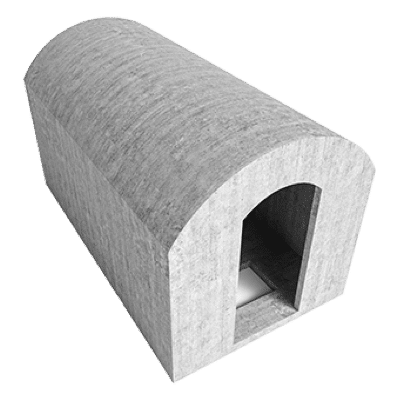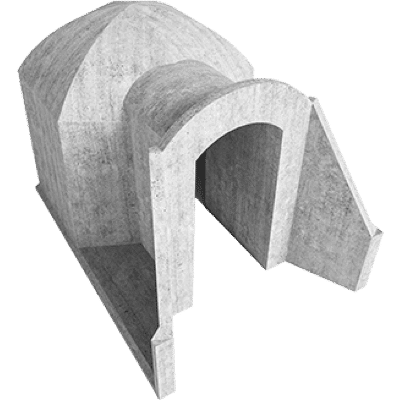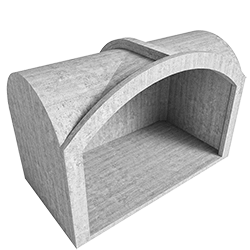Here you will find the answers to the most frequently asked questions.
If there is a question that was not answered, please submit it to our sales team!
MODULAR HOMES:
You can find out the prices of Revonia modular houses publicly on our modular houses page.
If you want a turnkey solution with project and permit application, special solutions and later landscaping, contact our sales team, who can recommend our good cooperation partners.
Revonia modular houses consist of modules of different sizes and purposes. A modular house with a size of 30 m2 consists of three modules that are connected to each other. House modules are monolithic, i.e. in one piece and have a floor, walls and ceiling. In house construction, we use three modules: arched vault, cross vault, dome vault.
If the house consists of arched vaults, no other preparation is needed for the installation than a properly sized rubble pad and an XPS/EPS insulation board on top of which to place the modules. If the house consists of cross vaults, we also highly recommend creating a simple strip foundation. This ensures that the installation is faster and easier. This also prevents the appearance of cracks on the surface of the finishing plaster in the future if the ground should rise or sink under the house. More detailed tips on installing the house can be found here!
In exactly the same way as in a normal small house – with natural ventilation. Today, natural ventilation is used as an energy-efficient building technology to reduce the building’s energy use at the expense of mechanical ventilation systems. Fresh air comes in and replaces the air circulating there. The amount of incoming and outgoing air can be adjusted with ceiling fans. In houses with a size of 60 m2 and more, we use ventilation with heat recovery system. We can also install ventilation with heat recovery in smaller houses. In humid rooms, we use a forced ventilation zone. For more precise control of air humidity and temperature, it is possible to install an air heat pump or forced ventilation in different parts of the house. You can read more information about ventilation on our blog here!
We recommend putting a 1 meter thick layer of mixed soil on top of the house. You can read more about the installation of houses here!
The standard price includes ready-to-install, finished house modules. The price includes the transport and installation service provided by us. The client must: apply for permits, prepare the site for installation, connect the connections to the house, cover the house with soil and create the front facade he likes.
Depending on your wishes, we can also create a solution in cooperation with our partners that covers everything from applying for permits, coordinating the installation of the house to exterior and interior finishing according to your wishes. Just choose the house you like the most and everything complicated will be done for you. What the standard house package includes can be found at the end of our price list here!
Our house can be connected to existing district heating, ground heating or other solutions. In their absence, the most popular options are an air heat pump, underfloor heating or, to create a cozy atmosphere, a wood-burning stove. Electric floor heating is included in the “Modular” options of our modular houses.
The closer you find the excavating contractor, the more likely it is that the end result will be faster and more affordable. If you can’t find an excavator near you, ask our sales team. During more than ten years of operation, we have developed good cooperation partners. You should mainly be looking for an Avant or excavator service provider who will do the initial site preparation and covering of the modules with soil after installation. Drawings and instructions for it come directly from us.
In terms of permits and legislation – not particularly. The walls of traditional houses are made of wood or stone material and insulated. Our houses have ~10cm thick concrete walls, cast as a module together with the foundation, they come in one piece with internal finishing and are later covered with a 1 meter thick layer of soil. The advantages of an underground house are: low energy costs, minimal maintenance, long life, immediate enjoyment as well as overall peace of mind.
Of course! We produce the entire house in our Estonian production unit. This means that almost everything is changeable. Each house is just as unique as its owner. Come for a free consultation and present your ideas to us.
The Revonia house is technically like a normal house, only with a green roof. There are no other differences in the big picture. Come and get acquainted with our options, complete the solution that suits you with a price quote, and then head to the bank with it.
For the installation of the Revonia house, it is necessary to create a rubble site of the right size, which must be 100 cm larger than the outer wall of the house. EPS or XPS board must be placed on top of the chipping pad according to the instructions. In the case of underground houses, it is up to the customer to decide how much soil to put on the sides and roof.
In the European Union, the concrete structures of homes finished and installed by us, and maintained according to the instructions, have a guarantee of 25 years. We provide a 2-year guarantee for the elements installed during the finishing process, unless otherwise stated. Although the constructions are guaranteed for 25 years, we have calculated the life of the concrete elements to be almost 100+ years.
In the eyes of the law, everything is just like a traditional house. Depending on the location and size, smaller houses may only need an installation notice or other law applicable to outbuildings. You can find the most accurate information from the responsible building advisor at your place of residence or from our design and permit application specialist.
Since each house is installed at a different depth, location, and with a different heating solution, we cannot uniquely determine the energy efficiency indicator for the houses. What we can say is that the underground house is a net-zero energy building, with the main energy win coming from the use of concrete and PUR foam and the geothermal benefits of the soil covering.
Although our houses cannot be directly qualified as bomb shelters, they are significantly stronger than ordinary houses. On our concrete modules, we have tested 3 x 81mm splinter mines from a distance of 4m, 3 x 105mm splinter mines from a distance of 2m, and after that also 2 x 120mm splinter mines from a distance of 1m. You can find more information about the results in our blog post.
Depending on the location, it is wise to build all structures above the water level or to create the necessary drainage that leads water away from the house. If there are problems with high ground water in the location, then a good solution is to install the house on-top-of-ground, and then when covering it with soil, turn it into a sod.
Depending on the wishes, the house can be installed below the ground level, completely hidden underground, in the side of a hill so that one side remains visible or on top of the ground. So far, the most popular has been to install the house at a depth of half a meter and then cover it with soil and thus create a grass bump in the yard. You can find various samples of installed houses on our references page.
Polyurethane foam, or PUR foam, is an insulation material that is installed by spraying. It creates a water-repellent layer on the surface of the concrete house, which also works as insulation. On average, the wall of the house has a layer of PUR foam 10-15 cm thick. We use closed cell foam.
You can see module sizes and assembly examples on our technology page, but to understand the real difference and size, we recommend you visit us or some of our projects.
Estimated lifetime is 100+ years.
The reinforced concrete shell of the house, which is covered with PUR foam and on which ~1m of soil is spread, is very well insulated. In addition, thanks to the use of geothermal energy, energy costs related to heating and cooling are minimal. Over time, the house becomes more and more nature-friendly thanks to the minimal repair factor, long life and positive impact on the surrounding nature. Compared to a normal house, our underground house is calculated to be 20-35% more energy efficient.
Retaining walls are the supporting elements to the left and right of the house entrance. They can be ready-made concrete elements, walls made of blocks, large earth stones or simply finished walls. Their main purpose is to hold the soil piled on top of the house and to insulate and protect the exposed part of the house. They are definitely needed, and they can be designed according to your wishes with many different options.
If the desire for a Revonia house is certain and a suitable option has been selected, we will also carry out a consultation on the property just in case. With this, we make sure that the access road can withstand our crane and that it can turn in the yard and be close enough to the installation site. Of course, all this is free of charge and ensures a smooth installation. We also use hard rubber mats to save the beautiful lawn and stone path. How the installation of the houses looks like can be seen in our video.
We prefer to install the houses with a boom truck that transports the modules from the factory to the installation site. The crane truck can lift the modules up to 7 meters from the center. If it is necessary to lift over surrounding houses, trees or other things that prevent the car from maneuvering next to the site, a separate crane must be used.
It is often believed that a house that is below ground is dark. In fact, it is not. Our house is similar to a normal house with light coming in from a window in the wall. We also use large, open floor-to-ceiling windows that ensure light-filled rooms. The installation of a skylight or light pipe has proven to be a popular choice in the back of houses, where the sun does not shine. The house can also be made open on two sides/ends, and in this case the sun passes through the house on both sides.
We can calculate all additional costs depending on the size and location of the project. For more detailed information, contact our sales representative and ask for an offer. Asking for a quote does not commit you to anything.
Yes, we believe so. Various accommodation facilities across Estonia and neighboring countries have trusted their guests to rest in our houses, and the feedback has been very positive. On our references page you can find samples of the work we have done, and on our business page you can also find a B2B calculator that helps you make initial sample calculations. The main reasons why our houses are preferred for renting out are: very fast installation, minimal maintenance, high-quality technology and durable construction, long life, low vacancy, unique appearance, nature-friendliness and low energy costs even when there are no tenants inside. We have also proven to be a popular choice in Finland, where our houses adorn several holiday villages.
By using an underground house with off-grid solutions, it is possible to hide the house under the soil and then install solar panels on top of the resulting turf. Thanks to the use of geothermal energy, the calculated power requirement of the required energy system is also lower. In addition, the costs of the off-grid building are lower when it is standing empty thanks to the covering with soil.
Cross vault modules can be used to create large and open spaces – living rooms, garages, dance halls.
Arched modules can be used to create smaller rooms with their own function – kitchen, bedroom, sauna room.
Domed vaults can be used to create small utility rooms – heating system/water filtration room, pantry, wine cellar.
All vault modules can be combined with each other and partitions can also be created if necessary. To better understand the difference in sizes, we recommend you visit us or book a time with our designer!
CELLARS:
The earth cellar with a size of 4.5 m2 does not have a floor attached to it, so that otherwise not enough moisture would enter the cellar. For cellars with a size of 4.5 m2 , we install a floor made of concrete blocks cut out on site. Larger cellar modules, however, have a concrete floor immediately attached and, according to wishes, also moisture openings with floor grates.
Cellars have natural ventilation. Fresh air comes in from the plafonds on the wall, and the air inside goes out from the pipes in the ceiling. Warm air rises up and leaves the cellar, cold air comes from below through the pipes. You can read about ventilation and how to regulate temperature, humidity and air volume here!
In 2022, we conducted measurements in our 11.7 m2 cellar in Salo, Finland. From the results, it can be concluded that the temperature in this cellar was very stable throughout the year. The average annual temperature was 7.2 degrees. The average summer temperature was 13.9 degrees, the average autumn temperature was 7.6 degrees, the average winter temperature was 2.7 degrees, and the average spring temperature was 4.4 degrees. The coldest was 2.2 degrees, when it was -14.3 degrees outside. However, the warmest temperature was 16.6 degrees when it was 24.3 degrees outside the cellar door. You can see the results in more detail in our blog post.
In the results of measurements made in Finland in 2022, the annual average humidity level was 82.1%. Stable temperature and high humidity are the most important factors in food preservation. The high humidity is what keeps the carrots crunchy and the low temperature ensures that these carrots last a long time. Which products require which temperature and humidity can be found here at the end of the post!
Looking at Revonia’s references, you have probably noticed that the interior walls and some exterior walls are covered with a rough, sometimes striped and mainly white covering material. This is lime plaster. Lime plaster is intended for plastering, filling and leveling of substrates both in outdoor and indoor conditions. It is suitable for use on facades, in dry and wet interiors, on walls and ceilings. Lime plaster is a very good choice for cellarsdue to its anti-mold effect and moisture-retaining properties. You can read more about the benefits, use and updating of lime plaster here!
When ordering a cellar from us, you can choose between a full package finished cellar or a DIY concrete module. The DIY option includes only a concrete body. A full earth cellar package with everything you need to store fresh food and fine drinks even the day after installation. The price list for our cellars shows what the prices include, and you can find more detailed information about additional options that can be installed in the cellar from the sales representative. In short, after the order, a hole must be dug, a crushed stone cushion must be created there and, if desired, an electric cable must be brought next to the location. Our installation team will come and install the cellar in a few hours. After that, it must be covered with soil on its own and, if necessary, retaining walls must be created. You can start using the cellar the very next day!
The closer you find an excavation contractor, the more likely it is that the end result will be faster and more affordable. If you cannot find an excavator nearby, you can also ask our sales team. During more than 10 years of operation, we have developed good cooperation partners. You should mainly be looking for an Avant or excavator service provider to do initial site preparation and later covering. Drawings and instructions for it come directly from us.
It is recommended to put 1 meter of mixed surface on top of the cellar.
Of course! Elements can be added, removed and changed. Since we produce the cellars 100% ourselves, we are also open to changes. If you have a similar request, contact a sales representative and ask for a solution to your idea!
For the installation of the Revonia cellar, it is necessary to create a rubble site of the right size, which must be 100 cm larger than the outer wall of the cellar. This also ensures plenty of room for last minute changes. How much soil to put on the sides and roof is up to the customer, but we recommend putting a 1 meter thick layer of mixed soil on the roof.
In the European Union, the concrete structures of earth cellars finished and installed by us and maintained according to the instructions have a guarantee of 25 years. We provide a 2-year warranty for elements installed in the finish, unless otherwise stated. Although the guarantee is 25 years, we have calculated the life of the concrete elements to be almost 100+ years.
There is no single answer here. Depending on location and size of the cellar it may only be require to have an installation notice or other law applicable to additional building. You can find the most accurate information from the responsible building advisor at your place of residence or from our design and permit application specialist.
Estonian General Riho Terras has said: “All our wars have been won over Grandma’s potato cellar!”
And we have designed our own cellars with exactly this way of thinking. We are so confident in the durability of our solution that we also conducted blast tests. In the same blasting test blog post, you can find tips on how to turn the cellar into a shelter if necessary.
It would be good to let us know in advance if you want to make a fire. For this, it would be necessary to make one ventilation pipe into a fireproof chimney and to create a greater air intake capacity.
It would be reasonable to build the cellar above the water line. In case of watery soil, drainage must be created around the cellar or the cellar must be installed on top of the ground and then covered with soil. It should be taken into account that there are also moisture openings in the cellar floor. If the water should come in through the moisture hole, it is probably so high that it has to go over the door jamb.
These are moisture holes with grates on them. From there, the required amount of moisture comes to the cellar, so that the products can be preserved for a long time. The grates are there to ensure that rodents do not get into the cellar and that the family has strong protection to step on.
Polyurethane foam, or PUR foam, is an insulation material that is installed by spraying. This creates a water-repellent layer on the surface of the concrete cellar, which also works as insulation. On average, the cellar wall has a 5-10cm thick layer of PUR foam. We use closed pore PUR foam.
The temperature of the cellar can be regulated by opening and closing the ventilation, structurally and also by opening and closing the door. Detailed instructions for this can be found here and here.
It sure is! It is possible to purchase an unfinished concrete body from us and do all the necessary work yourself. The prices of concrete bodies can be found at the end of the price lists. You can find the up-to-date price list of additional equipment from our sales representative.
Depending on the quantity to be stored, it would be reasonable to calculate how much shelf space/box space or cubic meters would need to be stored. It is definitely worth visiting us to get a better understanding of the different sizes. So far, the most popular cellar size has been 11.7 m2. You can find the sizes of the cellar modules on our technology page.
Our smallest cellar, i.e. the size of 4.5 m2, has retaining walls attached, but the larger ones would need to either build the retaining walls yourself or order them from us as a ready-made solution. The retaining wall is mainly needed to hold back the soil covering the cellar. Retaining walls can also be replaced with large earth stones or other constructional walls that can withstand the pressure of the soil.
If the desire for a cellar is certain and a suitable option is selected, we can also come there just in case and make sure that the access road can carry our crane and that it can turn in the yard and be close enough to the installation site. All this is, of course, free of charge when ordering and ensures a smooth installation. To save the beautiful lawn, we also use hard alloy mats. You can see what the installation looks like in our cellar installation video.
A popular option is to install electricity in the cellar to store and use a blender, stove, kettle and more. If there are no plans to make cellar for storage and there is no need for light in the cellar, then the works can also be carried out successfully with a battery-powered light source. It is worth considering that the later addition of electrical cabling and lighting will prove difficult.
Depending on the location and size of the project, all ancillary costs can be calculated in the initial quotation request.
SAUNAS:
The underground sauna is very well insulated and requires less energy consumption, for example to protect against freezing in winter. In addition, our saunas have a vaulted ceiling, which, thanks to air circulation, creates a uniquely mild steam experience that many are looking for. The underground sauna is also quieter, calmer and more private. In addition, you can create a front room for the sauna and completely hide the sauna house inside the hill covered with grass. Not many have such saunas.
Yes. Our cave sauna is one piece with floor, walls and ceiling.
By means of natural ventilation. Fresh air enters the sauna and replaces the air there. Hot and oxygen-poor air exits from the pipework in the ceiling, and fresh air enters through the wall. The amount of incoming and outgoing air can be adjusted with ceiling fans. We have also installed forced ventilation in damp rooms, which removes moisture faster. You can read more about ventilation on our blog here!
When you order a sauna from us, you can choose either a full package, finished sauna or DIY concrete sauna modules. The DIY option includes only a concrete body. The full package sauna includes everything you need to enjoy the pleasures of the sauna. The price list of our saunas shows what the prices include, and you can find more detailed information about additional options that can be installed in the sauna from the sales representative. In short, after confirming the order, you have to dig a hole, create a gravel pad there, place XPS or EPS insulation boards and, if desired, bring in sewage, water and electricity. Then our installation team comes with the sauna, installs it in a few hours, and after that all that remains is to cover it with soil, build retaining walls if necessary and start enjoying.
The closer the excavator is, the more likely it is that the end result will be faster and more affordable. If you can’t find an excavator nearby, you can also ask our sales team. During more than 10 years of operation, we have developed good cooperation partners all over the world. Mainly looking for an Avant or excavator service provider to do initial site preparation and later covering. Drawings and instructions for it come directly from us.
We recommend putting a 1 meter thick layer of mixed soil on top of the sauna. You can read more about sauna installation here!
Of course! Since we produce saunas in full in our Estonian production unit, this also means that almost everything can be changed. Each house is just as unique as its owner. Come for a free consultation and present your ideas to us.
For the installation of the Revonia sauna, it is necessary to create a gravel area of the right size, which must be 100 cm larger than the outer wall. In the case of underground saunas, it is up to the customer to decide how much soil to put on the sides and roof.
In the European Union, the concrete structures of homes finished and installed by us and maintained according to the instructions have a guarantee of 25 years. We provide a 2-year warranty for the elements installed in the finish, unless otherwise stated. Although the guarantee is 25 years, we have calculated the life of the concrete elements to be almost 100+ years.
Everything is just like a traditional outbuilding. Depending on the location and size, smaller saunas may only require an installation notice or other law applicable to the outbuilding. You can find the most accurate information from the building advisor responsible for your place of residence.
Since each sauna is installed at a different depth, location, and different heating solutions are chosen, we cannot clearly determine the energy efficiency indicator. What we can say is that the underground sauna is a nearly zero-energy building, the main energy gain of which comes from the use of concrete and the geothermal advantages of covering it with soil.
Depending on your wishes, we can create a solution in cooperation with our partners that includes everything from applying for permits, to sauna installation and exterior finishing. If you wish, you can also order everything or some things yourself. The most popular option is to prepare the installation site yourself with the help of a nearby bucket driver. After that, we bring the sauna, install it and finish the joints. The interior of the building is already in use. After we leave, the water and sewage pipe, the electricity connection must be connected, and the previously ordered bucketman must be called to cover the sauna house with soil. Depending on the wishes of the garden design, the surroundings of the sauna house and the front part of the facade, which will hold back the soil, must be finished. What interior elements and other things are included in the prices can be found at the end of our price list, which you can find here!
Polyurethane foam, or PUR foam, is an insulation material that is installed by spraying. It creates a water-repellent layer on the surface of the concrete module, which also works as an insulating layer. On average, there is a 5-10cm thick layer of PUR foam on the wall of the sauna house. We use closed-cell foam.
Of course! If you send us the model or drawings of the sauna heater, we can install it in the sauna. We have installed a number of designer heaters, electric heaters and wood heaters.
Moodulmaja, maakelder ja koobassaun Revonialt
Other questions:
In the European Union, our finished and installed modular concrete structures and maintained according to the instructions have a guarantee of 25 years. We provide a 2-year warranty for the elements installed in the finish, unless otherwise stated. Although the guarantee is 25 years, we have calculated the life of the concrete elements to be almost 100+ years.
You can familiarize yourself with the modules here – Modules and assembly examples
Works made from modules here – Cellars, Saunas, Houses
You can always visit us in Estonia to see the modules, samples and the manufacturing. There are different samples of a house, a sauna, a cellar and just a concrete module on site. Please let us know 1-2 days in advance of your arrival so that we can wait for you!
If a picture is worth a thousand words, the video probably says even more.
You can find the cellar/sauna installation video here and the house installation here.
As a rule, the customer himself. Each municipality and city has different laws and special features that must be taken into account in addition to the property’s own indicators. On request, we also have good cooperation partners who advise and help you apply for permits yourself.
Write us about your idea. We have the knowledge to carry out wells and solar panel houses, bunkers, shelters, specially shaped concrete elements as well as special projects.
Yes, sure! We have provided accommodations both in Estonia and further afield. You can find more information about them on our references page. Check out our B2B page here!
Of course! Buy an unfinished concrete body from us, add PUR foam and electricity or something similar if necessary and build doors, shelves and a canopy yourself.
All information found here is presented for informational purposes only, may change at any time and does not obligate Revonia OÜ. You can find information about up-to-date prices, conditions, offers and technical solutions from our sales representative. The final terms of payment will be determined during the project tender.




